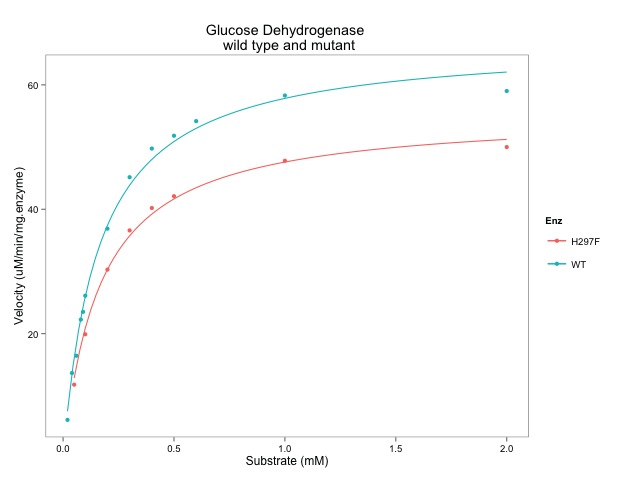The experimental set up is the same as we used previously, with the exception that we now have data from two drugs not one:
- add various concentrations of a two novels drug to the cells in culture
- leave for 48 hours
- then measure how many cells are dead
- the experiment was done multiple times with the doses improved as it progresses
The objective today is to draw a graph and calculate LD50s that allow us to compare the two drugs.
Here is an illustration of a graph that contains the data from both drugs:
Here is the script I used to generate this graph:
### I have detailed the code separately for each set of data
### to make it more obvious what I'm doing.
### The code could be made shorter and less repetitive.
### This is the data ###
# Data from multiple experiments
conc <- c(1.00E-08, 1.00E-07, 5.00E-07, 1.00E-06, 1.00E-05,
1.00E-08, 1.00E-07, 5.00E-07, 1.00E-06, 1.00E-05,
1.00E-08, 1.00E-07, 5.00E-07, 1.00E-06, 1.00E-05,
1.00E-07, 5.00E-07, 1.00E-06, 5.00E-06, 1.00E-05, 2.00E-05,
1.00E-07, 5.00E-07, 1.00E-06, 5.00E-06, 1.00E-05, 2.00E-05,
1.00E-07, 5.00E-07, 1.00E-06, 5.00E-06, 1.00E-05, 2.00E-05,
1.00E-07, 5.00E-07, 1.00E-06, 2.50E-06, 5.00E-06, 1.00E-05,
1.00E-07, 5.00E-07, 1.00E-06, 2.50E-06, 5.00E-06, 1.00E-05,
1.00E-07, 5.00E-07, 1.00E-06, 2.50E-06, 5.00E-06, 1.00E-05,
1.00E-07, 5.00E-07, 1.00E-06, 2.50E-06, 5.00E-06, 1.00E-05)
# First drug is called Drug 49
dead.cells49 <- c(28.6, 30.1, 34.6, 47.7, 81.7,
27.1, 27.2, 35, 47.9, 80.6,
27.8, 27.9, 34.2, 47.9, 82.4,
31.1, 37.6, 55.7, 89.1, 84.3, 85.2,
30.8, 35.6, 55.9, 90.5, 85.2, 86.3,
32.6, 34.7, 54.1, 89.8, 84.2, 87.1,
32.2, 34.4, 46.1, 76.2, 84.3, 84.1,
31.4, 37.4, 50.5, 75, 85.3, 84.8,
27.6, 37.3, 46.3, 74.1, 81.6, 82.7,
26.7, 28.4, 27.9, 59.6, 87, 86.1)
# Second Drug is called Drug 11
dead.cells11 <- c(28.4, 28.9, 28.6, 30.1, 90,
27.8, 28.5, 29.2, 29.3, 89.9,
28.6, 26.6, 27.3, 29, 89.7,
25.8, 28.7, 31, 80.7, 85, 85.2,
25.3, 28.2, 30, 81.4, 83.5, 87.2,
25.9, 25.4, 28.4, 81.2, 81.4, 85.6,
36.4, 36.2, 33.4, 52.3, 87.2, 97,
33.9, 29.5, 32, 44.8, 84.9, 97.2,
30.1, 30.1, 31, 46.5, 83.5, 96.1,
22.8, 23.7, 25.8, 37.9, 73.8, 86.7)
# Put the data into data frames and
# transform the data to make it postive for fitting
data49 <- data.frame(conc,dead.cells49)
data49$nM <- data49$conc * 1000000000
data49$log.nM <- log10(data49$nM)
data11 <- data.frame(conc,dead.cells11)
data11$nM <- data11$conc * 1000000000
data11$log.nM <- log10(data11$nM)
################## fit the data ##################
# make sure logconc remains positive, otherwise multiply to keep positive values
# (such as in this example where the iconc is multiplied by 1000
fit49 <- nls(dead.cells49 ~ bot+(top-bot)/(1+(log.nM/LD50)^slope),
data = data49,
start=list(bot=20, top=95, LD50=4, slope=-12))
fit11 <- nls(dead.cells11 ~ bot+(top-bot)/(1+(log.nM/LD50)^slope),
data = data11,
start=list(bot=20, top=95, LD50=4, slope=-12))
################## Plot the results ##################
#this lets you graph your calculated equations nice and pretty
x <- seq(0,6, length=100)
y49 <- (coef(fit49)["bot"]+(coef(fit49)["top"]-coef(fit49)["bot"])/(1+(x/coef(fit49)["LD50"])^coef(fit49)["slope"]))
m49 <- coef(fit49) #this extracts the fitted LD50 for drug 49
y11 <- (coef(fit11)["bot"]+(coef(fit11)["top"]-coef(fit11)["bot"])/(1+(x/coef(fit11)["LD50"])^coef(fit11)["slope"]))
m11 <- coef(fit11)
# plot the first set of points
plot(data49$nM, data49$dead.cells49,
log="x",
main="Comparing LD50 of two drugs ",
xlab="Drug concentration (microM)",
ylab="Dead cells (% of cells)",
xlim= c(500, 10000),
ylim= c(20,100),
xaxt = "n") # suppresses the labels on the x-axis
# add the points for the second set of data
points(data11$nM, data11$dead.cells11, col = "red")
# add the axis they way we want it to look
axis(1, at=c(500, 1000, 2500, 5000, 10000), lab=c("0.5","1","2.5","5","10"))
# adds the two non-linear fitted lines
lines(10^x,y49, lty="dotted", col="black")
lines(10^x,y11, lty="dotted", col="red")
# adds the legend
legend("topleft",
inset=.02,
c("Drug 49","Drug 11"),
lty=c("dotted","dotted"),
lwd=c(2.5,2.5),
col=c("black","red"),
cex = 0.75)
# add the LD50s in the legend which allows nice positioning.
rp = vector('expression',2)
rp[1] = substitute(expression(Drug49-LD50(microM) == MYVALUE),
list(MYVALUE = format((10^m49[3])/1000,dig=3)))[2]
rp[2] = substitute(expression(Drug11-LD50(microM) == MYVALUE),
list(MYVALUE = format((10^m11[3])/1000,dig=3)))[2]
legend('bottomright', legend = rp, bty = 'n', cex = 0.75)





No comments:
Post a Comment
Comments and suggestions are welcome.